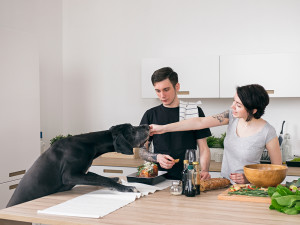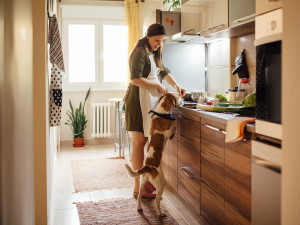3 Reasons to Cook Your Own Dog Food
DIYing meals is great for your pup’s health and your wallet.

share article

Your pet wants you to read our newsletter. (Then give them a treat.)
Like most people who have eyed the price tag of a new bag of kibble, you’ve probably considered making your own dog food. You may also be familiar with the idea that doing so can be much healthier for your dog and not as difficult as many think. Well, we’re here to tell you why there’s no better time than right now to take that first step. As is the case with most life-changing actions, the difficult part is the initial leap. The reward? The life you change may be your beloved dog’s.
From their perspective, there are three major benefits to fresh food. For starters, it can be more palatable — even the fussiest of eaters will appreciate your efforts. You also have control over what goes into each meal so you can include higher-quality ingredients, like more protein or a greater variety of dog-safe fruits and vegetablesopens in a new tab. Beyond that, no stabilizers are needed, so your dog won’t be consuming synthetic preservatives.
3 Reasons to Make DIY Dog Food
1. Tools make cooking a breeze.
The variety of readily available kitchen tools and supplies makes canine meal prep easier. With the revolution in home cooking, there are more tech-driven devices and affordable chef-grade tools available now than ever before. Electric pressure cookers, sous vide equipment, food processors and digital scales have joined that old standby, the crockpot, in many kitchens. All of these tools make the job of food preparation easier, more precise, and more efficient.
2. It can save you money.
If you’re feeding your dog generic kibble from Costco, it may be hard to beat what you spend on dog food. But if you’ve committed to premium kibble or one of the newer freshly made, home-delivered meal solutions, there’s a good chance that you’ll be able to lower spending on your dog’s food bill. And if you like to hunt for grocery-store bargains and/or have a vegetable garden, you’ll be surprised at just how much money you’ll be able to save.
3. It’s better for your dog’s health and wellness.
Is fresh homemade food better for dogs? Well, it’s no secret that most processed pet food opens in a new tabsuffer from a variety of quality issuesopens in a new tab. In order to mass-produce it and meet federal safety requirements, ingredients are cooked at very high temperatures to kill bacteria and pathogens. But because this process neutralizes the ingredients’ natural goodness, including the vitamins and minerals that benefit your dog, manufacturers have to add in supplements to replace what has been lost. Balanced homemade dog food can be much better for your dog.
Good News (and a Few Minor Caveats)
So, is fresh homemade dog food worth it? First, let’s disprove some major misconceptions. Home-cooked meals absolutely can be nutritionally balanced and complete. While it’s true that dogs require a balance of protein, carbohydrates, fats, vitamins and minerals, this can all easily be included at home. And despite the common belief, changing a dog’s diet does not have to be hazardous. Most dogs can tolerate some variety or at least subtle variations of food. Introducing home-cooked components to your dog’s diet as toppersopens in a new tab, a small secondary meal, or a combination of fresh food and kibble will give you a way to ease into a home-cooked regime.
However, there are a couple of caveats. Like people, some dogs are sensitive to specific ingredients, most often protein sources, which is why it’s a good idea to start with a simple ingredient list. If your dog develops itchy ears, excessive scratching or diarrhea (or other signs of GI upset), it will be easier to identify the culprit. Additionally, if your dog is a senior, a puppy, or has a medical condition that requires a particular food regime — for example, pancreas or kidney issues — it’s best to consult with a nutritionist to devise a recipe plan.
Outside of these scenarios, cooking our dogs’ meals can be one of the most meaningful actions we can take to benefit their health and well-being. Plus, it’s very satisfying. Unlike human family members, our dogs never complain that their food isn’t picture-perfect or that it’s overcooked or too bland. Rather, they appreciate the extra-fresh ingredients, care and love put into each bite.
Disclaimer alert: This article is here to share information. But, much like pineapple on pizza, the topic may be controversial. Meaning, not all vets or pet professionals agree. Because every pet is a unique weirdo with specific needs. So, don’t take this as fact or medical advice. Talk things over with your vet when making decisions, and use your best judgment (about both your pet’s health and pizza toppings).

Claudia Kawczynska
Claudia Kawczynska was co-founder and editor-in-chief of The Bark for 20 years. She also edited the best-selling anthology Dog Is My Co-Pilot.
Related articles
![Young couple petting their dog in the kitchen while they make homemade kibble]() opens in a new tab
opens in a new tabHow to Make Homemade Dog Kibble
Learn how to make dry dog food with this easy homemade dog kibble dish.
![Dog biting into a bunch of carrots]() opens in a new tab
opens in a new tabHow to Get Your Dog the Vitamins and Minerals They Need
Your pup needs their greens, too.
![Pomeranian stands in front of a yellow bowl of homemade probiotic yogurt]() opens in a new tab
opens in a new tabAre Probiotics Actually Something Your Dog Needs?
Time for a (literal) gut check from four experts.
![Pregnant woman cooks recipe in the kitchen with her dog]() opens in a new tab
opens in a new tabYou — Yes, You — Can Make Your Dog Homemade Chicken and Vegetables
Behold: the power of a home-cooked meal.





